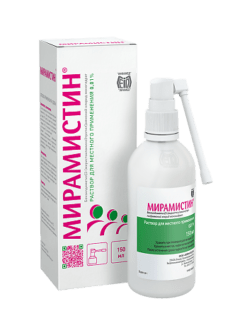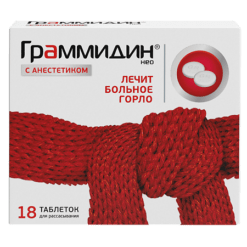-
×


-
×


Subtotal: €23.11




Subtotal: €23.11




Subtotal: €23.11
€7.00 €6.00
ATC: S.01.G.A.04 Oxymetazoline
Oxymetazoline belongs to the group of local vasoconstrictors (decongestants) with alpha-adrenomimetic action, causes narrowing of the blood vessels of the nasal mucosa, thus eliminating edema and hyperemia of the nasopharyngeal mucosa.
When applied topically to the inflamed nasal cavity mucosa it reduces its swelling and associated mucus hypersecretion (nasal discharge) which facilitates nasal passages drainage and leads to restoration of nasal breathing.
The reduction of nasal mucous membrane edema helps restore aeration of the sinus cavities and middle ear cavity which prevents the development of bacterial complications (maxillary sinusitis, sinusitis, otitis media).
In local intranasal application in therapeutic concentrations it does not irritate and does not cause nasal mucous membrane hyperemia.
Oxymetazoline begins to act from 25 seconds. The duration of action of the drug is up to 12 hours.
The results of a double-blind, placebo-controlled study in patients with acute viral rhinitis aged 12-70 years showed that use of oxymetazoline 0.05% reduced the median duration of a runny nose from 6 to 4 days.
Oxymetazoline has no systemic action when administered topically intranasally. The half-life of oxymetazoline when administered intranasally is 35 h. 2.1% of oxymetazoline is excreted by the kidneys and about 1.1% through the intestine.
.
– Treatment of acute respiratory conditions accompanied by runny nose;
– allergic rhinitis;
– vasomotor rhinitis;
– For restoration of drainage in sinusitis, eustachitis, otitis media;
– to eliminate swelling before diagnostic manipulations of the nasal passages.
In one dose:
The active ingredient:
Oxymetazoline hydrochloride – 22.5 mcg.
The excipients: levomenthol (L-menthol) – 18 µg, eucalyptus twig leaf oil (eucalyptus oil) – 18 µg, dinatrium edetate dihydrate – 22.5 µg, sodium hydrophosphate dodecahydrate – 1260 µg, Sodium dihydrophosphate dihydrate – 562.5 micrograms, propylene glycol – 4500 micrograms, benzyl alcohol – 450 micrograms, benzalkonium chloride – 6.8 micrograms, purified water – up to 0.045 ml.
Intranasally.
Adults and children over 6 years of age: 1 injection in each nasal passage 2 to 3 times a day.
If symptoms get worse or there is no improvement within 3 days, a doctor should be consulted. At the recommended dose without consulting a physician, use for no more than 7 days.
In frequent and prolonged use, nasal congestion may reappear or worsen. If these symptoms occur, discontinue treatment and see a physician.
A single 45 µL injection contains 22.5 µg oxymetazoline hydrochloride.
In concomitant use with monoamine oxidase inhibitors (within the previous 2 weeks and within 2 weeks after their withdrawal), tricyclic antidepressants or other drugs that contribute to increased blood pressure, increased blood pressure may be observed.
The drug slows absorption of local anesthetic drugs, prolonging their effect.
The co-administration of other vasoconstrictors increases the risk of side effects.
Avoid getting the drug in the mouth, eyes or around the eyes.
In contact with the eyes may cause visual impairment.
It is recommended that the maximum time and recommended doses not be exceeded when using the drug alone, especially in children.
If there is no reduction or if symptoms worsen, see a physician.
Long-term use (more than one week) may cause tachyphylaxis, ricochet effect and atrophy of the nasal mucosa.
The drug should be used individually to avoid spread of infection.
– Hypersensitivity to the drug components;
– atrophic (dry) rhinitis;
– Closed angle glaucoma;
– condition after transsphenoidal hypophysectomy;
– surgery on the dura mater (history);
– childhood under 6 years of age;
– inflammation of the skin and mucous membrane of the vestibule area.
In elevated intraocular pressure, chronic heart failure, arterial hypertension, angina pectoris; arrhythmia; chronic renal failure; In patients with prostatic hyperplasia with clinical symptoms (urinary retention); marked atherosclerosis; hyperthyroidism; diabetes mellitus; pheochromocytoma; tachycardia; therapy with monoamine oxidase inhibitors (MAO) (includingup to 14 days after their withdrawal) and tricyclic antidepressants, as well as other drugs that increase blood pressure; porphyria; pregnancy, during breastfeeding.
The frequency of adverse reactions was determined according to the World Health Organization classification: very common (â¥10%), common (â¥1% and < 10%), infrequent (â¥0.1% and < 1%), rare (â¥0.01% and < 0.1%), very rare (< 0.01%), frequency unknown (cannot be calculated based on available data).
Disorders of the immune system:
Infrequent: Quincke’s edema, itching.
Nervous system disorders:
Rarely: headache, insomnia.
Very rarely: fatigue, drowsiness, anxiety, hallucinations.
Disorders of the cardiovascular system:
Infrequent: tachycardia, increased blood pressure.
Rarely: sensation of palpitations.
Respiratory system, chest and mediastinum disorders:
Often: burning or dryness of the nasal mucosa, sneezing.
Infrequent: feeling of “stuffy” nose (reactive hyperemia); nasal bleeding.
Very rare: respiratory arrest (in infants).
Muscular and connective tissue disorders:
very rarely: seizures.
Systemic side effects of the drug: dizziness, anxiety, irritability, sleep disturbance (in children), nausea, exanthema, visual disturbance (in case of eye contact).
Long-term or continuous use of vasoconstrictors may lead to tachyphylaxis, nasal mucosal atrophy, and recurrent nasal mucosal edema (medicated rhinitis).
The clinical signs of intoxication with imidazole derivatives may be nonspecific and indistinct, as phases of hyperactivity are replaced by phases of depression of the central nervous system, cardiovascular and respiratory systems.
Symptoms: anxiety, restlessness, hallucinations, seizures, decreased body temperature, lethargy, sleepiness, coma, constriction or dilation of the pupils, fever, sweating, paleness, cyanosis, palpitations, bradycardia, arrhythmia, cardiac arrest, increased blood pressure, decreased blood pressure, nausea, vomiting, depressed respiration, respiratory arrest.
In children, overdose may cause central nervous system symptoms such as: agitation, seizures, coma, bradycardia, respiratory arrest, and an increase in blood pressure followed by a possible decrease in blood pressure.
Treatment: gastric lavage, administration of activated charcoal (in case of accidental ingestion of the drug); symptomatic.
In case of severe overdose intensive hospital therapy is indicated. The use of vasoconstrictors is contraindicated.
When using during pregnancy or breastfeeding the recommended dosage should not be exceeded. The drug may be used only if the potential benefit to the mother exceeds the potential risk to the fetus or child.
Caution should be exercised in the presence of arterial hypertension or signs of decreased placental blood flow. Frequent or prolonged use of the drug in high doses may result in decreased placental blood flow.
Consult your doctor before using the drug if you are pregnant or think you might be pregnant or are planning to become pregnant.
| Weight | 0.031 kg |
|---|---|
| Shelf life | 2 years. Do not use after the expiration date. |
| Conditions of storage | Store at a temperature not exceeding 25 ° C. Store out of the reach of children. |
| Manufacturer | Pharmstandard-Leksredstva, Russia |
| Medication form | dosed nasal spray |
| Brand | Pharmstandard-Leksredstva |
Buy Rhinostop Extra with menthol and eucalyptus, spray 15 ml with delivery to USA, UK, Europe and over 120 other countries.